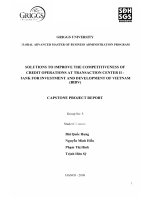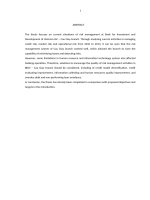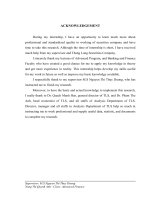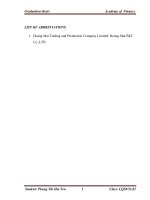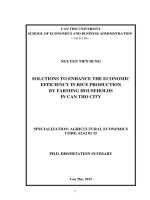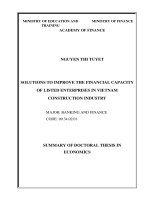Solutions to improve the efficiency of the import process at LONG AN GENERAL IMPORT EXPORT DUCK FEATHER JOINT STOCK COMPANY (LADCO)
Bạn đang xem bản rút gọn của tài liệu. Xem và tải ngay bản đầy đủ của tài liệu tại đây (736.66 KB, 57 trang )
MINISTRY OF FINANCE
INTERNATIONAL SCHOOL OF FINANCE – MARKETING
PRACTICUM REPORT
INSTRUCTURE:
RESPONSIBLE BY:
STUDENT ID:
COURSE : IP_20
MAJORING IN:
Ho Chi Minh city, April 2023
MINISTRY OF FINANCE
INTERNATIONAL SCHOOL OF FINANCE – MARKETING
PRACTICUM REPORT
Solutions to improve the efficiency of the import process
at LONG AN GENERAL IMPORT EXPORT DUCK
FEATHER JOINT STOCK COMPANY (LADCO)
INSTRUCTURE: PhD. Nong Thi Nhu Mai
RESPONSIBLE BY: LA GIA HUY
COURSE : IP_20DKQ
MAJORING IN: INTERNATIONAL BUSINESS
Ho Chi Minh city, April 20
TOPIC: Analyzing and improving sales efficiency of Thuan Lien Company
ACKNOWLEDGMENT
First and foremost, I would like to express my gratitude to all the esteemed
professors at the University of Finance and Marketing who have provided me with
the opportunity to gain a better understanding and work within the business
environment.
Especially, I sincerely thank Professor Nguyen Phi Hoang for his kindness and
guidance throughout my internship period, as well as for assisting me in
completing this internship report.
I also extend my heartfelt appreciation to the entire Thuận Liên Company for their
support and guidance during my internship there. The company's staff and
colleagues have helped me gain practical experience, learn from experts, and
develop essential skills in the workplace.
Despite my diligent efforts in research and understanding, the limitations of time
and knowledge have led to certain shortcomings in this report. Thanks to all the
guidance and feedback received, I have had the opportunity to improve myself and
grasp crucial aspects in my field of work.
I sincerely express my gratitude.
2
TABLE OF CONTENT
TABLE OF FIGURES
LIST OF TABLE
3
OVERVIEW OF THE PRACTICUM REPORT
1. Reasons for choosing the topic
One of the most important activities, has the effect of ending the process of saving
product information to the end consumer in the business process to collect money, turn
capital quickly and continue the process of recycling. That social production is sales.
Selling is a science and also an art. However, in each person, each object, each
commercial enterprise has its own way of selling, but the basic purpose is the first and the
last of all businesses is how to sell products, get high profit but must maintain credibility
with customers. To achieve results in sales, sales management activities must be sensitive
and flexible.
Thuan Lien Company is a significant consumer goods firm, so improving business
efficiency is critical; it has a direct impact on the Company's existence and development.
Company. I chose the topic based on that awareness and my internship at Thuan Lien
Company: “Analyzing and improving sales efficiency of Thuan Lien Company”.
2. Objectives of the study
Discover how Thuan Lien Private Company conducts sales activities and sales
management, and then propose some suggestions and recommendations to improve sales
management.
3. Objects and scope of the research
Due to knowledge and time constraints, the report only mentions the status of Thuan Lien
Private Company's business operations and sales administration, as well as transaction
data from 2019 to 2021.
4. Research methods
This topic is researched utilizing a logical method, statistical analysis, and the knowledge
gained during the learning process in conjunction with real-time observations and
income. Practice in the workplace. Combining book and document synthesis with inputs
from the company's management board and my own subjective thoughts.
4
5. Report structure
In addition to the introduction, conclusion, the content reference includes 3 chapters:
Chapter 1: General theoretical basis of sales activities
Chapter 2: Actual situation of sales activities of Thuan Lien private company
Chapter 3: Some solutions to improve sales activities of Thuan Lien private company
5
Chapter I
GENERAL BASIS OF SALES ACTIVITIES
1.1 The concept, nature and role of sales activities
1.1.1 Concept of Sales Operation
Selling is an economic activity aimed at selling the producer's goods to all different
consumers in society. However, due to different approaches and different research
purposes, in reality there are many different conceptions of sales.
According to Philip Kotler, “Sales is a form of direct introduction of goods and
services through exchange and conversation with potential buyers to sell goods”.
James M. Comer defines "Selling is a process in which a seller discovers, elicits,
and satisfies a buyer's needs or desires in order to satisfy the long-term interests of both
parties".
John W. Ernest & Richard Ashmun once said that “Sales is the process of
identifying the needs and wants of potential buyers, presenting the product in such a way
that it leads the buyer to a buying decision”.
Thus, although there are differences in expression and scope, the above concepts also
have many similarities. And with the above approaches, we can understand: Sales is a
process where the seller does not merely meet the needs and wants of the buyer, but
includes the stages of understanding, discovering needs, even create demand and then
satisfy the needs of buyers.
1.1.2 The Nature of Sales Operation
The essence of sales activities is to protect not only the seller's interests but also the
buyer's interests. People in the sales force are given many titles such as salesperson, sales
representative, director in charge of customers, and so on, but they all have one thing in
common: they are in contact with clients and are directly responsible for selling a
company's products or services.
1.1.3 The Role of Sales Operation
6
Sales play an extremely important role in the operation of the business. First, sales
is a basic business that directly performs the function of moving goods from places of
excess to places of demand. According to the law of supply and demand, where there is
an excess of goods, the price will be low, whereas where there is a shortage of goods, the
price will be high, so selling goods in places where there is a shortage of goods will earn
higher profits than in places where there is a shortage of goods. have surplus goods. This
is the driving force for businesses to move goods from places of excess, low price to sell
in places where goods are scarce, with high price to earn higher profits. Therefore, selling
is an important stage associated with production and consumption, ensuring the balance
between supply and demand for each specific item, contributing to stabilizing market
prices.
Selling is also an important operation to fulfill the business purpose of the
enterprise: profit, position, safety in business. Therefore, for any business, profit is
always a business resource, a long-term and regular goal in business activities of the
business. Therefore, sales promotion activities decide to increase profits for businesses.
Selling goods, making a profit, having a position in the market will ensure the safety of
the business. Moreover, sales also decide and govern other operations in the business
process of the enterprise such as: market research, purchasing sources, service activities,
and inventory.
Salespeople serve as a vital link between companies and their clients, impacting
trust, reputation, and the reproduction of consumer requirements. As a result, having an
effective sales team is a potent commercial competitive weapon.
In summary, in the market economy, sales performance reflects the business results of the
business, the efforts and efforts of the enterprise in the market, and at the same time
shows the organizational level, capacity operating of the business. Not only that, sales are
also the basis for comparison with other businesses in the same industry.
1.2 Classification of sales options and sales forms
1.2.1 Classification of sales options
7
The sales force of an enterprise includes individuals and organizations directly
involved in the sales process of the business. Sales force includes the sales force on the
payroll of the enterprise and the sales force outside the enterprise.
Sales force of the enterprise's payroll:
This force includes all employees who are directly responsible for sales activities
and is divided into two categories: sales at the enterprise and sales in the area. This force
includes:
- Sales force at the enterprise: This force usually works in the offices of the
enterprise and uses fax, phone, email, etc. to deal with customers. Salespeople in this
force rarely have direct contact with customers.
- Local sales force: These are the people who directly sell the business's products to
customers and provide customers with services through direct transactions in the area.
Sales force outside the enterprise
This sales force is often spread out geographically. For a sales force outside the
business to function effectively, the number of customers in that territory must be large
enough. This force consists of sales agents and collaborators.
- Sales agents: They are natural or legal persons who perform one or more acts
related to sales activities under the mandate of the business.
- Contributors: These are people who have an agreement with the business to sell
to the business in the market. This force is not part of the company's employees and is
entitled to commissions or discounts on sales.
1.2.2 The Sale forms
Sales are classified as follows:
Based on the delivery location for the customer
Selling at the supplier's warehouse: suitable for buyers who need to buy in large
quantities, have stable consumption and have available means of product transportation.
Selling through stores, stalls suitable for small needs, wide product portfolio, stable
consumption cycle.
8
Selling directly to consumer units, selling at home at the request of customers,
creating convenience for buyers.
This method mainly improves the quality of customer service and competition
among sellers.
According to product rotation
Wholesale: Selling in large quantities, based on contracts, and with non-cash
payments. At the end of the wholesale process, the products remain in circulation and
have not yet entered consumption.
Retail: Selling to individual consumers' small-scale needs, meeting customers'
immediate demands, and requiring immediate payment. Due to the various stages of
wholesale, warehousing, and sales costs that products go through, the retail price is
usually higher than the wholesale price. While increasing a business's sales volume might
be slower, it receives direct feedback from consumers.
According to selling methods
Contract Selling: This selling method is applied to important goods and involves
selling in large quantities. During the contract execution, both parties demonstrate
responsibility and respect for each other's interests.
Auction: Certain types of goods, such as those in large quantities, non-standardized
items, or specialized products, are auctioned to find buyers at the highest price.
Export: This is a specialized selling method that requires compliance with the
government's import and export regulations. Only entities permitted to engage in import
and export activities are allowed to execute this method.
According to payment relationships:
Cash Purchase: Cash purchase involves buying and paying immediately upon goods
delivery. With this method, businesses receive immediate payment, ensuring financial
security, but it can be challenging for customers who may not have the capability to pay
immediately.
Installment Sales: In this method, the buyer pays for the purchased item in multiple
installments. In addition to the regular selling price, businesses also charge the buyer an
9
interest for the delayed payments. In essence, with this method, the seller retains
ownership rights until the buyer completes the full payment.
1.3 Sales Process
To achieve high sales efficiency, building an effective sales process is crucial.
Typically, each business will have its own sales process tailored to the nature of the
company's operations. However, at its core, the sales process in a business usually
consists of seven main steps:
Bảng 1.1. Quy trình bán hàng trong doanh nghiệp
Tìm kiếm và tiếp
nhận thơng tin về
khách hàng
Xử lý thông tin và
nhận biết khách
hàng tiềm năng
Tiếp cận khách hàng
Đưa ra đề xuất, cung
cấp các giải pháp
phù hợp với nhu cầu
của khách hàng
Phân tích nhu cầu
khách hàng
Tìm kiếm cơ hội
Đàm phán, ký hợp
đồng mua bán
10
(Nguồn: Bán hàng và quản trị bán hàng,David Jobber &Geoff Lancaster Trần
Đình Hải biên soạn, NXB Thống Kê, 2002)
Step 1 : Searching for and Collecting Customer Information
This is the initial step in the sales process, aimed at identifying potential customers.
There are various methods to gather information, and this information is categorized into
two types: internal business sources and external business sources.
Internal business sources encompass the current customers of the business, internal
information within the company (such as from the marketing department, colleagues,
suppliers, competitors...).
External business sources include information acquired from media outlets,
personal relationships, seminars, events...
Identifying and collecting information about potential customers lays the
foundation for successful engagement in the sales process.
Step 2: Processing Information and Identifying Potential Customers
A potential customer is an individual or organization with sufficient financial
capacity and decision-making ability to purchase a business's products or services. This
group may provide limited immediate value but can yield substantial value to the
business in the future. Therefore, when processing customer information, the company
gains the opportunity to understand their expectations regarding products and services for
the future. Employees need to gather specific information for different customer
segments and input it into the company's customer database.
For individual customers:
Name, age, address, contact phone number;
Educational background, current occupation;
Customer's current income;
Spending habits, personal preferences;
Customer's familiarity with the product;
What information the customer needs regarding the product.
11
For business customers:
Company name, address, phone number, email, fax;
Name, title, phone number, email of the decision-maker for purchasing products;
Company type: limited liability company, joint-stock company, state-owned
company, foreign-owned company;
Business area of operation;
Company's financial status;
Company's market reputation.
Collecting and processing customer information enables the company to develop
specific approaches to engage potential customers effectively.
Step 3 : Customer Engagement
The objective of step 3 is to approach and schedule an appointment with the
customer. Businesses have various methods to arrange meetings with customers, such as
utilizing intermediaries, leveraging connections with partner businesses, or using email
and phone communications. Importantly, prior to meeting with the customer, employees
need to clearly define the purpose of the meeting, adequately prepare relevant documents,
and outline the presentation content in a clear and coherent manner. Sales representatives
should also know how to initiate a greeting with the buyer to establish the foundation for
future interactions.
Step 4: Seeking Opportunities
In order to identify opportunities, effective questioning techniques are essential
when communicating with customers. One of the most common question techniques is
Neil Rackham's S.P.I.N technique:
S (Situation Question): These questions limit small talk and focus on details to grasp the
customer's current situation.
P (Problem Question): These questions explore difficulties and current needs of the
customer.
12
I (Implication Question): These are intricate and nuanced questions. They elevate the
customer's issues to a higher level, discussing potential consequences if current problems
are not resolved.
N (Need-pay off Question): After presenting the customer with concerning consequences
from their actual situation, the salesperson asks how the customer intends to address their
difficulties. Skillful questioning can prompt the customer to propose using the company's
product or service before it's introduced.
Beyond gathering information through questions, after obtaining the information, sales
personnel need to classify customer groups. Customers are divided into two groups:
Active Customers: These are customers who are qualified to buy the company's
product or service or have clear purchasing needs.
Passive Customers: These are customers who possess the qualifications to buy the
product or service but lack a clear purchasing need.
Step 5: Customer Needs Analysis
Customers typically have five basic types of needs as follows:
Safety Needs: Customers often fear risks when purchasing any product. Therefore,
they tend to trust products with clear technical specifications and origins.
Convenience Needs: The key factor that drives customers to purchase a product is
that they need to invest minimal effort but receive maximum satisfaction.
Novelty Needs: Customers tend to be curious and always seek novelty, things that
haven't been present in previous products or services.
Prestige Needs: Customers desire that using a product will reflect their superiority
and status compared to others.
Price Needs: Customers always desire to acquire a good product or service at the
lowest possible price.
Especially when analyzing customer needs, sales personnel need to identify the gaps
in customers' needs and find ways to fill those gaps by answering the following
questions:
- What does the customer already have?
13
- What does the customer not have yet?
- What should the customer have?
- What does the customer want to have?
Step 6: Presenting Proposals, Providing Appropriate Solutions to Customer
Needs
Customers almost always raise objections during the product introduction or when
proposing a purchase. To address these objections, sales personnel must maintain a
positive attitude and offer suitable solution proposals.
Businesses offer proposals and various solutions in line with customer
requirements, including:
Quotation: Providing a price estimate for the product or service.
Payment Methods: Offering options for how the customer can make payments.
Delivery Time, Location, and Method: Specifying when, where, and how the
product will be delivered.
Warranty and Product Maintenance: Explaining the warranty terms and any product
maintenance services.
Additional Services: Offering additional services such as inspections or after-sales
support.
Other Support: Providing training for staff members or other technical assistance.
Technical Solutions: Offering technical solutions alongside the product.
Step 7: Negotiation, Contract Signing, and Deal Closure
The negotiation process aims to guide all parties towards an agreement and an acceptable
contract framework that aligns with the objectives of both sides. Before entering into any
economic contract, thorough consideration of terms such as unit price, quantity, timing,
location, delivery method, payment method, warranty, maintenance, contract penalties,
disputes, and contract validity is necessary. Only after careful review should the contract
be signed, marking the conclusion of the business deal.
1.4. Sales Activity Management
14
Sales management is a closely integrated process that spans from setting goals for sales
personnel, creating sales plans, to recruiting, training, monitoring, and evaluating the
performance of the sales force. Therefore, establishing a well-rounded system of sales
activity management steps is a crucial factor in creating favorable conditions for
implementing sales plans. Thus, sales activity management can be depicted through the
following diagram:
Diagram 1.1: Sales Activity Management Process
Xây dựng mục tiêu bán hàng
Xây dựng cấu trúc, tổ chức lực lượng bán hàng
Tuyển dụng và đào tạo nhân viên bán hàng
Xây dựng và triển khai kế hoạch bán hàng
Động viên lực lượng bán hàng
Giám sát và đánh giá hiệu quả bán hàng
(Nguồn: Lê Đăng Lăng, Kĩ năng và quản trị bán hàng , NXB Thống Kê, 2009)
1.4.1 Developing Sales Goals
Developing sales goals is one of the first and most crucial tasks for a sales manager.
The process of setting sales goals typically revolves around key objectives such as
15
revenue or volume targets, market coverage goals, new market development goals,
market share goals, and profit goals.
Revenue or Volume Targets
A revenue target is the total value of products or services that need to be achieved
through sales efforts within specific timeframes. Revenue targets should be specific,
measurable, achievable, and have tangible outcomes. In addition to revenue goals, sales
managers can also set volume targets – the quantity of products to be sold within a
specific time period. When setting these goals, they should be based on factors such as
previous year's sales results, industry growth rates, competitive landscape, etc. This
information is typically drawn from sales performance reports and the marketing
department.
It is important to meticulously determine sales goals as they provide direction and
motivation for the sales team. Well-defined and achievable goals help ensure effective
planning and resource allocation for the sales activities.
Market Coverage Goals
Market coverage goals are reflected through the extent of market coverage that a
business aims to achieve. This includes the number of sales points where the business's
products are present in the market, as well as the quantity of product units available at
each sales point. In practical business scenarios, market coverage goals often encompass
both the number of sales points and the quantity of products at each sales point.
New Customer Development Goals
Developing new customers plays a highly significant role and serves as the
foundation for growth. In the sales realm, new customers can be those newly reached
within the current sales channels (increasing coverage) or customers obtained through
new sales channels or territorial expansion. Due to this nature, managers often align new
customer development goals with market coverage objectives.
Expanding the customer base is crucial for business growth, and setting goals to tap
into new markets helps diversify and broaden the customer portfolio. These goals
16
encourage sales teams to actively seek out and engage potential customers, contributing
to the overall success of the business.
Market Share Goals
Market share refers to the percentage ratio between the current customer base and
the total potential customer base within the target market. Market share goals represent
the percentage of customers acquired within the total target customer base to be achieved
over a specific period after sales efforts have been undertaken. These goals should be
specific, achievable, time-bound, and measurable. The basis for establishing market share
goals relies on the company's achieved market share in the previous business period, the
market shares of competitors, market size, and the investment resources allocated to the
market.
Profit Goals
Profit goals entail the level of profit that a business aims to achieve through its
organizational sales activities within a specific timeframe. This profit can be either total
profit or profit for each product line. However, for ease of calculation, managers often
use a target profit percentage for sales goals instead of specifying a specific profit
amount. When developing profit goals, attention should also be given to determining
factors such as measurability, feasibility, time frame, and having a basis. Several bases
for establishing profit goals include overall business objectives, sales volume, product
costs, management, and promotional efforts.
1.4.2 Building Sales Force Structure and Organization
An effective organizational chart will assist a business in achieving its overarching
strategic objectives. The design of this structure should efficiently provide the level of
service that customers demand, while simultaneously achieving the outlined sales and
profit goals. Currently, there are various organizational options tailored to specific
business situations, including:
17
Geographical Area-Based Sales Network Organization
18
Diagram 1.2: Geographical Area-Based Sales Network Model
(Nguồn: Giáo trình quản trị bán hàng)
Organizing by geographical area is the most fundamental approach to sales force
organization based on territories. Regional sales managers hold full authority to decide on
the business of products within the enterprise's product portfolio for all customers in their
respective territories.
19
